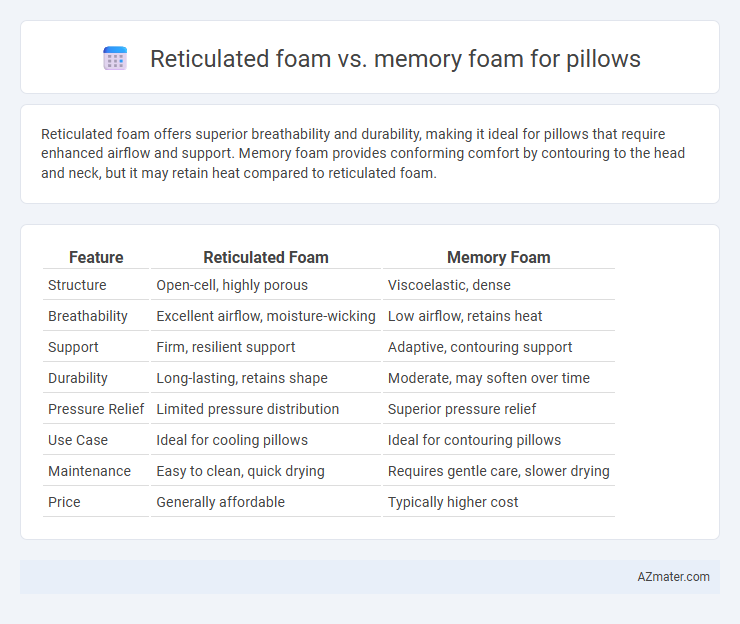Reticulated foam offers superior breathability and durability, making it ideal for pillows that require enhanced airflow and support. Memory foam provides conforming comfort by contouring to the head and neck, but it may retain heat compared to reticulated foam.
Table of Comparison
| Feature | Reticulated Foam | Memory Foam |
|---|---|---|
| Structure | Open-cell, highly porous | Viscoelastic, dense |
| Breathability | Excellent airflow, moisture-wicking | Low airflow, retains heat |
| Support | Firm, resilient support | Adaptive, contouring support |
| Durability | Long-lasting, retains shape | Moderate, may soften over time |
| Pressure Relief | Limited pressure distribution | Superior pressure relief |
| Use Case | Ideal for cooling pillows | Ideal for contouring pillows |
| Maintenance | Easy to clean, quick drying | Requires gentle care, slower drying |
| Price | Generally affordable | Typically higher cost |
Introduction to Reticulated Foam and Memory Foam
Reticulated foam is a highly breathable material characterized by an open-cell structure that enhances airflow and moisture wicking, making it ideal for pillows that require cooling and durability. Memory foam, known for its viscoelastic properties, contours closely to the shape of the head and neck, providing exceptional pressure relief and support by responding to body heat and weight. Comparing these foam types highlights reticulated foam's superior ventilation versus memory foam's contouring comfort, which directly affects pillow performance and user sleep experience.
Material Composition and Structure
Reticulated foam consists of a highly porous open-cell structure that enhances breathability and airflow, making it ideal for cooling pillow applications. Memory foam is composed of viscoelastic polyurethane, offering slow-response cushioning that contours closely to the head and neck, providing pressure relief and support. The structural difference lies in reticulated foam's rigid, reticulated network versus memory foam's dense, viscoelastic composition, impacting durability and comfort levels.
Breathability and Airflow Comparison
Reticulated foam features an open-cell structure that promotes superior breathability and airflow compared to traditional memory foam, which tends to retain heat due to its dense composition. The porous design of reticulated foam allows for continuous air circulation, reducing moisture buildup and enhancing cooling effects during sleep. Memory foam pillows, while contouring to the head and neck, often trap body heat, making them less effective for breathability and temperature regulation.
Support and Pressure Relief
Reticulated foam offers enhanced airflow and breathable support, making it highly effective in maintaining consistent spinal alignment and reducing heat buildup. Memory foam excels in pressure relief by contouring closely to the body's curves, evenly distributing weight to minimize pressure points during sleep. Both materials provide distinct benefits for pillow support, with reticulated foam favoring ventilation and durability, while memory foam prioritizes personalized comfort and pressure modulation.
Durability and Longevity
Reticulated foam offers exceptional durability due to its open-cell structure, which promotes airflow and resists deterioration over time, making it ideal for long-lasting pillow support. Memory foam, while providing superior contouring and pressure relief, tends to compress and lose its shape faster, reducing its lifespan compared to reticulated foam. For longevity, reticulated foam pillows maintain firmness and structural integrity significantly longer, especially under frequent use or in humid environments.
Hypoallergenic Properties
Reticulated foam offers superior hypoallergenic properties due to its open-cell structure, which enhances airflow and reduces moisture buildup, preventing dust mites and mold growth. Memory foam, while contouring well to the head and neck, tends to retain heat and moisture, creating a less ideal environment for allergens. For allergy sufferers, reticulated foam pillows provide a more breathable and hygienic option, minimizing the risk of allergic reactions.
Temperature Regulation
Reticulated foam offers superior temperature regulation compared to memory foam due to its open-cell structure, which promotes increased airflow and quicker heat dissipation. Memory foam tends to retain body heat because of its dense, slow-reacting material that conforms closely to the sleeper's shape, potentially causing discomfort in warmer conditions. Selecting reticulated foam pillows is ideal for individuals seeking cooler sleep environments and enhanced breathability.
Maintenance and Cleaning
Reticulated foam offers superior breathability and quick drying, making it easier to maintain and clean due to its open-cell structure that resists moisture buildup and mold growth. Memory foam absorbs more moisture and oils, requiring more delicate cleaning methods like spot cleaning or specialized foam-safe cleaners to prevent degradation. Regular airing and use of removable pillow covers enhance the longevity and hygiene of both types of foam pillows.
Cost and Value Considerations
Reticulated foam pillows generally cost less than memory foam options, offering affordable durability and breathability with an open-cell structure that enhances airflow and moisture wicking. Memory foam pillows, while pricier, provide superior contouring support, pressure relief, and long-term comfort, justifying the higher investment for those with specific orthopedic or sleep quality needs. Value considerations depend on individual preferences for support, cooling, and budget constraints, with reticulated foam favored for cost-efficiency and memory foam for enhanced ergonomic benefits.
Choosing the Right Foam for Your Pillow Needs
Reticulated foam offers superior breathability and durability, making it ideal for hot sleepers or those seeking firm support, while memory foam contours closely to the head and neck, providing pressure relief and personalized comfort. Choosing the right foam depends on your sleeping style, temperature preferences, and support requirements; side sleepers may benefit from memory foam's cushioning effect, whereas back or stomach sleepers might prefer the responsive firmness of reticulated foam. Consider factors like airflow, support level, and allergen resistance to match the foam type to your individual pillow needs effectively.

Infographic: Reticulated foam vs Memory foam for Pillow
 azmater.com
azmater.com